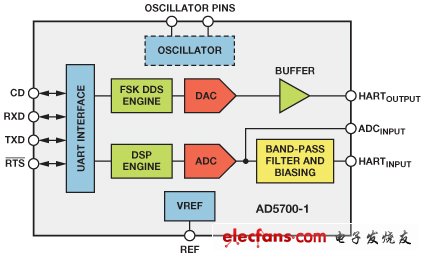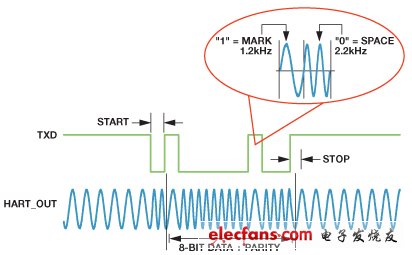Explain the improved HART communication technology using IC
Since the early industrial revolution, people have needed to use machinery and equipment for measurement, control, and communication. Instrumentation systems using sensors and actuators have become the backbone of modern manufacturing plants. Through the transmission line, the communication method that uses 4mA to 20mA analog current signal for data transmission and setting has been widely used for a long time. However, the instrument is also maturing, from the early pure analog system to the currently used "smart" system, using HART® (addressable remote sensor high-speed channel) protocol and other technologies to enhance the communication function. In short, the DC low-frequency circuit signal is modulated by an independent higher frequency signal, and the signal is switched between a pair of frequencies (Figure 1)-this technique is called frequency shift keying (FSK).

Figure 1. HART communication.
This article will introduce the implementation of the technology, and provide some application examples, discuss some of the devices used in modern silicon integrated circuit technology, to help system designers. In addition, in order to explain the technology, we will also introduce the most compact, lowest power consumption, widest voltage range, fully compliant with HART modem (modulation-demodulation) IC—AD5700 of Analog Devices.
What is HART communication?
The main communication method used in the analog transmitter is the current loop, the normal range is from 4mA to 20mA, using the transmitter, receiver and power supply equipment. It can realize many functions, such as remote calibration, fault query and process variable data transmission. Low-power transmitters and receivers must operate at a minimum current of 4mA or lower, depending on the "margin" required for error indication. These current loops are very reliable and stable, and have strong resistance to environmental interference in long-distance communication. However, one of its major disadvantages is that the single loop allows only one-way communication (from the sensor or sent to the actuator) and can only transmit one process variable.
The introduction of the HART standard provides a way to create "smart" transmitters by adding digital communication capabilities and sharing the same twisted pair used for traditional 4mA to 20mA instruments. The 4mA to 20mA analog circuit is modulated by the 1mA peak-to-peak FSK signal—without interrupting the original primary variable transmission—while still leaving room for loop operation. The HART protocol has become a global standard for sending and receiving digital signals through analog lines between smart devices and control or monitoring systems.
Internal structure of HART modem IC
The AD5700-1 complete HART modem IC (Figure 2) integrates all necessary filtering, signal detection, demodulation, and signal generation functions, thereby significantly reducing the number of external components required. It is available in a small 4 mm & TImes; 4 mm, 24-lead LFCSP package, requiring only a single power supply from 2V to 5.5, and operates over an extended temperature range of –40 ° C to + 125 ° C.

Figure 2. Block diagram of AD5700-1; -1 option
Includes internal 0.5% precision RC oscillator.
Launch path
Figure 2 shows the main modules involved in modulation: FSK direct digital synthesis (DDS) engine, DAC (switched resistor string type) and buffer. The digital data to be sent is input through the UART. The modulator is enabled by pulling the RTS (request to send) signal low. The modulator converts the UART-encoded HART data bit stream at the TXD input into a series of binary 1200Hz ("1") and 2200Hz ("0") tones (see Figure 3). DDS generates a sine digital word stream at any frequency, and the DAC converts it to a pp analog sine wave of approximately 493mV. This sine wave signal is internally buffered and output on the HART_OUT pin. The DDS engine itself generates continuous phase signals, so it avoids any output discontinuities when switching between frequencies. The main advantage of internal buffering on HART_OUT is the high drive capability, no need for external analog buffering, and the problems they cause. The HART_OUT pin is DC biased to 0.75V and should be capacitively coupled to the load. For more detailed information, please refer to the AD5700 / AD5700-1 data sheet.

Figure 3. AD5700 / AD5700-1 modulator waveform.
Iron Hanging Lamp a creative pendant light.
Iron shade hanging lamp can create the perfect mood and give a stylish, good quality finish to your space.
Iron hanging lighting is suitable for home decoration, 5 star hotel, project such as mansion, villa or bar and so on it is also suitable for matching with furniture at home.
Iron hanging lamp,Iron hanging lighting,Iron shade hanging lamp
Monike lighting , https://www.monikelight.com